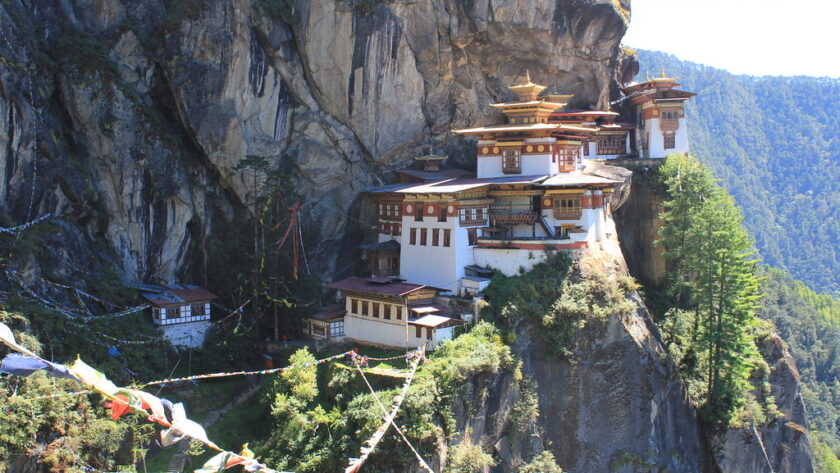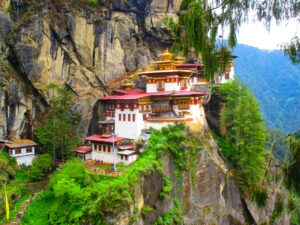Perched precariously on the edge of a 3,000-foot cliff in Bhutan, the Tiger’s Nest Monastery, or Paro Taktsang, is a sight that can steal your breath away. Imagine a sacred sanctuary, seemingly suspended in the mist, a testament to human faith and architectural wonder. This revered site is not just a place of worship but a symbol of Bhutan’s rich cultural heritage and spiritual depth.
Why Tiger’s Nest Monastery Is an Unforgettable Adventure
Nestled in the Himalayan mountains, the journey to Tiger’s Nest is as mesmerizing as the destination itself. It beckons adventurers, spiritual seekers, and cultural enthusiasts alike, offering a blend of natural beauty, historical richness, and spiritual serenity. Here, we briefly introduce 12 compelling reasons why Tiger’s Nest Monastery should top your adventure bucket list. From the challenging trek that rewards you with breathtaking views, to the profound peace that envelops you upon reaching the monastery, every step of this journey promises an unforgettable experience.
12 Reasons Why Tiger’s Nest Monastery Should Be Your Next Adventure
Nestled in the majestic Himalayas, Tiger’s Nest Monastery in Bhutan is a destination that combines natural beauty, spiritual significance, and architectural wonder. Known locally as Paro Taktsang, this iconic monastery offers an adventure like no other. Here are 12 reasons why it should be next on your travel list.
1. Breathtaking Location & Scenic Hike
The monastery’s dramatic setting, perched on a cliff 3,000 feet above the Paro valley, offers a visual spectacle that few places on Earth can match. The journey to Tiger’s Nest is equally mesmerizing, featuring:
- Scenic beauty: The hike weaves through lush forests, past ancient prayer wheels and across crystal-clear streams, offering stunning vistas of the Bhutanese landscape.
- Diverse appeal: Whether you’re an avid hiker or someone looking for a spiritual journey, the trek to Tiger’s Nest caters to various fitness levels, challenging yet rewarding each visitor with its breathtaking views.
- Unique atmosphere: The path is dotted with colorful prayer flags that flutter in the wind, adding a layer of mystical allure to the trek.
2. Spiritual Significance & Cultural Immersion
Tiger’s Nest Monastery is not just a tourist attraction; it’s a profound spiritual site with deep historical roots in Bhutanese Buddhism.
- Historical importance: The monastery is said to be the meditation site of Guru Rinpoche (Padmasambhava), who introduced Buddhism to Bhutan. This makes it a key pilgrimage site for devotees.
- Cultural experience: Visiting Tiger’s Nest offers a deep dive into Bhutanese Buddhist culture. You’ll have the chance to see monks in their traditional robes, spin prayer wheels, and immerse yourself in the peaceful chants that resonate through the halls.
- Unique practices: Witnessing the hoisting of prayer flags or participating in a monastery ritual provides insight into the deeply spiritual lifestyle of the Bhutanese people.
3. Architectural Marvel & Artistic Beauty
The construction of Tiger’s Nest Monastery is an architectural feat, with structures that seem to defy gravity as they cling to the cliffside.
- Innovative architecture: The monastery’s buildings are masterfully built into the rock face, showcasing Bhutanese craftsmanship’s ingenuity and respect for nature.
- Artistic interiors: Inside, the monastery houses a treasure trove of Buddhist art, including intricate murals, statues, and thangkas that tell stories of deities, saints, and mythical creatures.
- Harmony with nature: The monastery’s design complements its natural surroundings, creating a serene and sacred atmosphere that enhances the spiritual experience.
4. Sense of Achievement & Personal Challenge
Reaching the Tiger’s Nest Monastery is not just about witnessing a remarkable site; it’s about the journey and the personal triumphs along the way.
- Fulfillment: The feeling of accomplishment that comes from completing the hike and standing before the monastery is unparalleled. It’s a reminder of what you can achieve with determination and perseverance.
- Testing limits: The trek to Tiger’s Nest offers a unique opportunity to challenge your physical and mental boundaries in a positive manner. It’s a journey that tests your endurance and rewards you with a sense of personal growth and strength.
5. Unique Photo Opportunities
The journey to and the arrival at Tiger’s Nest Monastery offer some of the most spectacular photographic opportunities in the world.
- Breathtaking panoramas: The hike provides a plethora of stunning vistas of the Himalayan landscape. Each turn presents a new, breathtaking view, perfect for capturing the grandeur of Bhutan’s natural beauty.
- Iconic backdrop: The monastery itself, with its distinctive architecture and dramatic cliffside setting, serves as an extraordinary backdrop for photos. These images not only capture the beauty of the site but also the essence of your adventure.
6. Escape the Ordinary & Embrace Adventure
Visiting Tiger’s Nest Monastery is an invitation to step out of your daily routine and into the extraordinary.
- Break from the routine: This adventure offers a rare chance to escape the mundane aspects of everyday life. It’s an opportunity to experience something truly unique, surrounded by the natural beauty and tranquility of the Himalayas.
- Reconnect with nature: The trek to Tiger’s Nest is a chance to disconnect from the digital world and reconnect with the natural world. It’s a journey that refreshes the mind, body, and soul, surrounded by the serene beauty of Bhutan’s landscape.
7. Gateway to Bhutan
Bhutan, known as the “Land of the Thunder Dragon,” is a country where happiness is valued above economic growth. It’s a place of deep cultural richness, spiritual significance, and natural beauty. The Tiger’s Nest Monastery stands as a majestic introduction to this unique nation.
- Introduction to Bhutanese culture: By visiting the monastery, travelers get a taste of Bhutan’s rich traditions, spiritual life, and breathtaking landscapes, encouraging further exploration of the country.
- Exploring further: The journey to Tiger’s Nest opens up opportunities to delve deeper into Bhutan, from its serene valleys and traditional villages to its vibrant festivals and sacred sites.
8. Limited Numbers & Permit System
The experience of visiting Tiger’s Nest Monastery is made even more special by Bhutan’s commitment to preserving its sacredness and natural beauty.
- Controlled access: To protect the site and ensure a peaceful visit for pilgrims and tourists alike, access to the monastery is carefully controlled. This means you can explore this spiritual place without the crowds found at other major tourist destinations.
- Permit process: Visitors need to obtain a permit, part of Bhutan’s approach to managing tourism sustainably. Planning your visit involves coordinating with registered Bhutanese tour operators, ensuring your experience is both seamless and respectful of local regulations and customs.
9. Sustainable Travel & Eco-Tourism
Bhutan’s approach to tourism is deeply rooted in the principles of sustainability and conservation.
- Sustainable tourism: By prioritizing eco-tourism and sustainable practices, Bhutan aims to preserve its natural and cultural heritage. This includes measures like the permit system and limiting visitor numbers to sites like Tiger’s Nest.
- Contributing to conservation: Your visit to the monastery supports Bhutan’s sustainable tourism efforts. The fees and regulations help fund conservation projects and ensure that travel has a positive impact on the country’s environment and communities.
10. Memorable Experience & Personal Growth
A visit to the Tiger’s Nest Monastery transcends a simple journey; it becomes a transformative experience that enriches your life and leaves you with memories that last a lifetime.
- Unforgettable memories: The unique combination of natural beauty, spiritual atmosphere, and physical challenge ensures that your adventure to Tiger’s Nest will be remembered for years to come.
- Self-discovery: The journey offers more than just physical exercise; it provides a rare opportunity for introspection and personal growth. Many travelers find that they discover new things about themselves and gain a fresh perspective on life.
11. Culturally Diverse & Welcoming People
The warmth and hospitality of the Bhutanese people add a special dimension to the experience of visiting Tiger’s Nest Monastery.
- Warm hospitality: Bhutanese culture is renowned for its hospitality and the welcoming nature of its people. Visitors often feel a genuine warmth and openness that enhances their travel experience.
- Cultural immersion: Engaging with the locals and experiencing their way of life offers insights into a culture that has been carefully preserved through the centuries. It’s an opportunity to learn, share, and celebrate the diversity of human traditions.
12. Beyond the Monastery: Exploring Bhutan
While the Tiger’s Nest Monastery might be the highlight of your trip to Bhutan, the country has much more to offer in terms of adventures and experiences.
- Cultural festivals: Bhutan is famous for its colorful and vibrant festivals, such as the Paro Tshechu, where you can witness traditional dances, music, and costumes.
- Historic dzongs: The country is dotted with impressive dzongs, which serve both as monastic homes and administrative centers. Exploring these fortress monasteries provides a deeper understanding of Bhutanese history and architecture.
- Trekking adventures: Beyond the hike to Tiger’s Nest, Bhutan offers a range of trekking experiences that lead you through some of the most pristine and untouched landscapes in the world.
Conclusion
The Tiger’s Nest Monastery in Bhutan is a unique blend of natural beauty, spiritual significance, architectural marvel, and cultural immersion. From the breathtaking hike up the Himalayan slopes to the profound peace within its sacred walls, this destination offers an adventure that is both challenging and deeply rewarding. The controlled access ensures an exclusive experience, while the focus on sustainable tourism aligns with the values of conscious travelers. The journey to the monastery is a chance for personal growth, unforgettable memories, and an intimate glimpse into the heart of Bhutanese culture. Beyond the monastery, Bhutan opens up a world of further exploration, from vibrant festivals to serene treks across untouched landscapes.
We encourage you to plan your journey and experience the magic of the Tiger’s Nest Monastery for yourself. Discover the blend of adventure and serenity that awaits in the Land of the Thunder Dragon.
FAQ (Frequently Asked Questions)
How difficult is the hike to the Tiger’s Nest Monastery?
The hike to the monastery is considered moderate to challenging, depending on your fitness level. It typically takes around 4 to 6 hours for a round trip. It’s important to pace yourself, stay hydrated, and wear comfortable, sturdy shoes.
Do I need a permit to visit the Tiger’s Nest Monastery?
Yes, you need a permit to visit the monastery. The process is managed through registered tour operators in Bhutan as part of your travel package, ensuring a smooth and regulated visit.
What is the best time to visit the Tiger’s Nest Monastery?
The best time to visit is during spring (March to May) and fall (September to November) when the weather is clear, and the views are spectacular. These seasons offer the ideal conditions for hiking and enjoying the scenery.
What are some things to pack for my trip to the Tiger’s Nest Monastery?
Essentials include comfortable hiking shoes, weather-appropriate clothing (layers are recommended due to changing conditions), water, snacks, sunscreen, a hat, and your camera to capture the stunning views.
How do I get to the Tiger’s Nest Monastery?
The journey begins in Paro, where most visitors arrive by plane. From Paro, you can arrange for a car or taxi to take you to the base of the hike. Guided tours often include transportation as part of their package.





